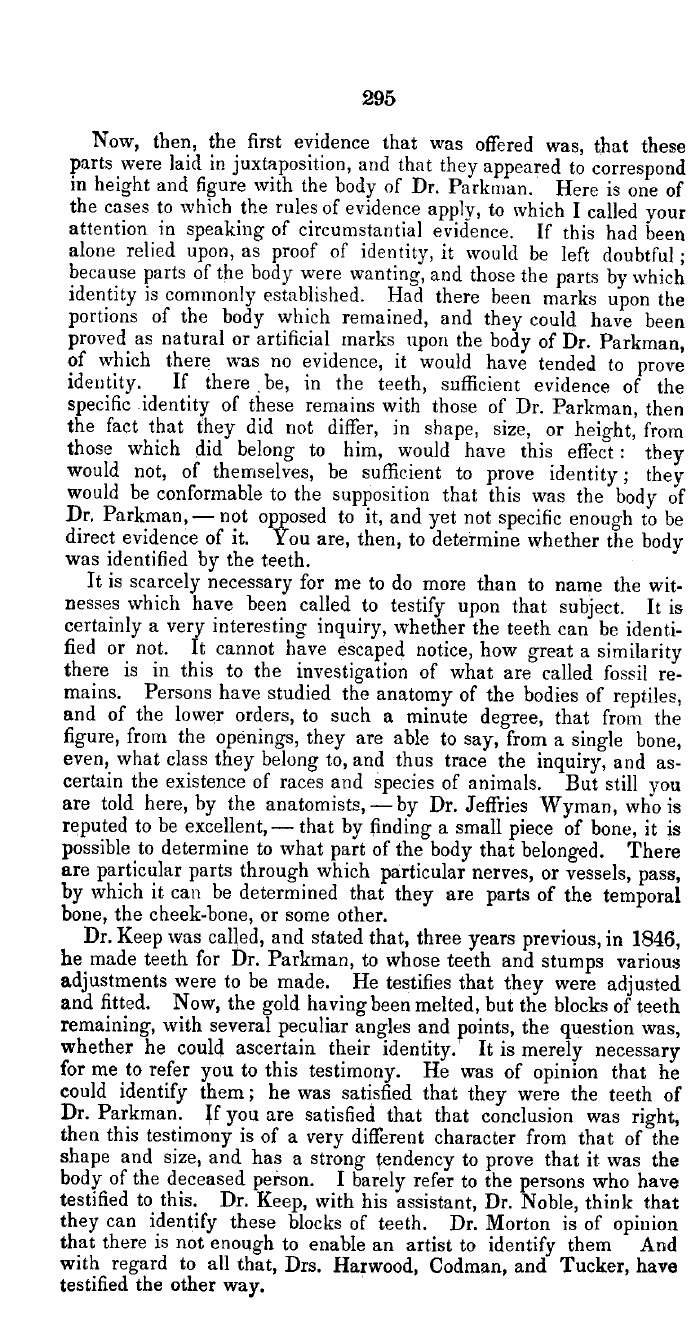|
295
Now, then, the first evidence that was offered was, that these
parts were laid in juxtaposition, and that they appeared to correspond
in height and figure with the body of Dr. Parkman. Here is one of
the cases to which the rules of evidence apply, to which I called your
attention in speaking of circumstantial evidence. If this had been
alone relied upon, as proof of identity, it would be left doubtful ;
because parts of the body were wanting, and those the parts by which
identity is commonly established. Had there been marks upon the
portions of the body which remained, and they could have been
proved as natural or artificial marks upon the body of Dr. Parkman,
of which there was no evidence, it would have tended to prove
identity. If there be, in the teeth, sufficient evidence of the
specific .identity of these remains with those of Dr. Parkman, then
the fact that they did not differ, in shape, size, or height, from
those which did belong to him, would have this effect: they
would not, of themselves, be sufficient to prove identity ; they
would be conformable to the supposition that this was the body of
Dr. Parkman,-not opposed to it, and yet not specific enough to be
direct evidence of it. You are, then, to determine whether the body
was identified by the teeth.
It is scarcely necessary for me to do more than to name the wit-
nesses which have been called to testify upon that subject. It is
certainly a very interesting inquiry, whether the teeth can be identi-
fied or not. It cannot have escaped notice, how great a similarity
there is in this to the investigation of what are called fossil re-
mains. Persons have studied the anatomy of the bodies of reptiles,
and of the lower orders, to such a minute degree, that from the
figure, from the openings, they are able to say, from a single bone,
even, what class they belong to, and thus trace the inquiry, and as-
certain the existence of races and species of animals. But still you
are told here, by the anatomists,-by Dr. Jeffries Wyman, who is
reputed to be excellent,-that by finding a small piece of bone, it is
possible to determine to what part of the body that belonged. There
are particular parts through which particular nerves, or vessels, pass,
by which it can be determined that they are parts of the temporal
bone, the cheek-bone, or some other.
Dr. Keep was called, and stated that, three years previous, in 1846,
he made teeth for Dr. Parkman, to whose teeth and stumps various
adjustments were to be made. He testifies that they were adjusted
and fitted. Now, the gold having been melted, but the blocks of teeth
remaining, with several peculiar angles and points, the question was,
whether he could ascertain their identity. It is merely necessary
for me to refer you to this testimony. He was of opinion that he
could identify them; he was satisfied that they were the teeth of
Dr. Parkman. If you are satisfied that that conclusion was right,
then this testimony is of a very different character from that of the
shape and size, and has a strong tendency to prove that it was the
body of the deceased person. I barely refer to the persons who have
testified to this. Dr. Keep, with his assistant, Dr. Noble, think that
they can identify these blocks of teeth. Dr. Morton is of opinion
that there is not enough to enable an artist to identify them And
with regard to all that, Drs. Harwood, Codman, and Tucker, have
testified the other way.
|

